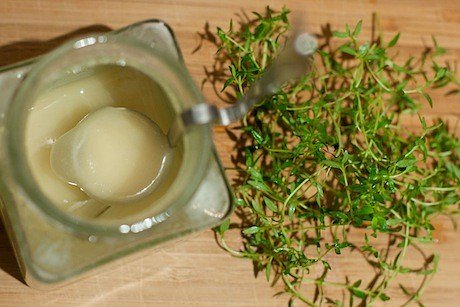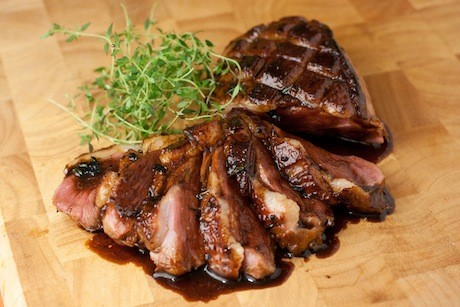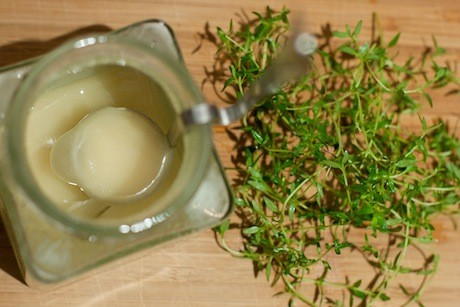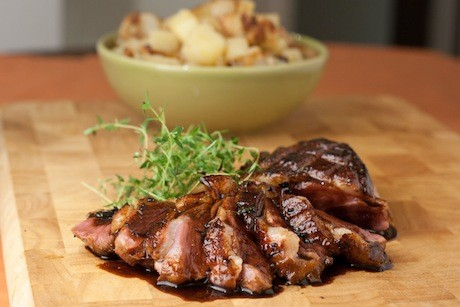Magret de Canard au Miel (Seared Duck Breast with Honey)

Mon 15 Oct 2012

In France it seems that there are few culinary trends as divisive as sucré-salé (mixing sweet and savory ingredients in one dish). The combination of sweet and savory is not that uncommon in French cuisine, yet for many the idea of a dish based on opposing flavors can be a little difficult to swallow (if you’ll pardon the pun!). A quick flip through some of my French cooking magazines reveals this skepticism with headlines like “Osez le sucré-salé!” (“Dare the Sweet and Savory!”) and “N’hésitez plus!” (“Don’t Hesitate Any Longer!”).

For those who are a bit more adventurous, there are actually quite a few French dishes featuring a delightful mix of sucré-salé ingredients. There are obvious classics such as canard à l’orange (duck with orange), boudin noir aux pommes (blood sausage with apples) or lapin aux pruneaux (braised rabbit with prunes), but modern French cuisine also features many sucré-salé combinations, and magret de canard au miel (seared duck breast with honey) is a perfect example.

The fatty skin of the duck breast scored in a crosshatch pattern.
In this recipe the duck breast is seared in the pan so that the outside is crispy yet the inside remains juicy and pink. A sweet honey-and-balsamic-vinegar sauce is made by deglazing the pan and is drizzled over the duck just prior to serving. Between the savory duck and caramelized honey, the depth and contrast of flavors is surprisingly rich, and the dish is best enjoyed with a bold red wine for a sumptuous dîner en amoureux (a romantic dinner). That is, if your dining companion is not against the idea of mixing sucré-salé flavors, of course!

Magret de canard au miel with sautéed potatoes.
Magret de Canard au Miel (Seared Duck Breast with Honey)
Serves 2.
1 medium duck breast, skin on
1 tablespoon balsamic vinegar
3 tablespoons honey
1/3 cup veal stock (or chicken stock)
1/2 tablespoon fresh thyme leaves (plus extra, to garnish)
salt and pepper
1. Remove the duck breast from the fridge 15–20 minutes before cooking to bring to room temperature.
2. Score the fatty skin of the duck breast in a crosshatch pattern (see photo above). Season both sides with salt and pepper.
3. On the stove, heat a large pan over medium heat. Pat the duck breast dry, then place in the pan, skin side down, and sear for 5 minutes (use a mesh splatter guard to reduce potential mess). Remove the duck breast and sprinkle the skin with a pinch of salt. Discard the excess fat from the pan, then return the duck breast immediately to the pan and cook the other side for 4 minutes. Brush the now-crispy skin with a teaspoon of the honey and turn to cook skin side down for 1 more minute. Remove from the pan and set to rest for 10 minutes on a chopping board, skin side up, loosely covered in foil.
4. Meanwhile, discard any excess fat, then deglaze the pan with the balsamic vinegar, veal stock and the rest of the honey. With a wooden spoon, gently scrape free all the little bits that are stuck to the bottom, add the thyme leaves and simmer gently for 2 minutes to thicken. Pour into a sauceboat.
5. Slice the duck breast and place on a serving plate, drizzling a little of the sauce over the top, keeping the rest of the sauce for serving.
6. Serve with sautéed potatoes (pictured above), pommes à la dauphinoise or a celeriac and potato mash.
NOTE: Cooking times can vary according to personal preferences, but the standard way of serving duck breast in France is rosy pink inside. As some people prefer meat to be well cooked, it is also possible to sear pieces separately in the pan after slicing to finish them off.
Editor’s note: If you are a foodie heading to Paris, why not download one of our three gourmet walking trips or our package of foodie walks for the iPhone?